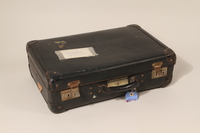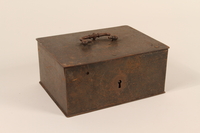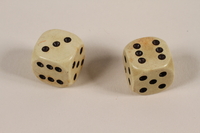Overview
- Description
- The papers consist of six photographs of members of the Visser family, one photograph of a group of men and women at the Joodsche Schouwburg the day before their deportation, and letters and postcards sent from Visser family members at Vught and Westerbork concentration camps to Schoontje Visser [mother of Elisabeth Munichman].
- Credit Line
- United States Holocaust Memorial Museum Collection, Gift of Elisabeth and Maurits Munichman
- Collection Creator
- Elisabeth Munichman
Maurits Munichman - Biography
-
Elisabeth Blind was born in Amsterdam, Netherlands, in 1932, to Cornelius Blind and Schoontje Visser. Schoontje was born on December 2, 1909, to Benjamin Visser, born on August 28, 1875, in Amsterdam, and Henriette Brilleslyper, born on June 21, 1880, in Friedland. Schoontje had six siblings: Levi, born on June 29, 1907, Jacob, born on November 16, 1913, Sara, Betsy, Max, and Josef, who was born on December 2, 1909 and died before the war. Cornelius and Schoontje divorced in the late 1930s.
Germany occupied the Netherlands on May 10, 1940. Schoontje obtained false identity papers for herself and Elisabeth and they went into hiding. With the help of the Dutch underground, in particular Willem Schalbroeck, they were moved from place to place. They kept a small suitcase that was always packed to take to the cellar during bombing raids.
At one point, Elisabeth and Schoontje hid with the Mooi family. They also lived on Burmenstraat which had bunkers at the end of the street where the Germans held Jews until trucks came to take them away. One day, Elisabeth was sent to get milk. As she walked to the store, a Dutch neighbor suspected of being a German sympathizer and who often listened to German music, followed her and asked the owner why he let in a Jew. The owner knew Elisabeth was Jewish, but told the woman that she was not. The woman dragged Elisabeth out by the hair. Elisabeth often searched through rubbish to fill a wagon with potato peels, and then would walk for hours in her wooden shoes to trade the peels to farmers for food and milk.
Schoontje’s sister, Betsy Swaab, her husband Sam, and children, Jacob and Henriette, lived nearby. Elisabeth would bike to her house to get some sugar. In spring 1943, she saw a crowd watching Germans collect Jews for deportation. Elisabeth snuck near and watched as her Aunt Betsy and her thirteen year old cousin, Henriette, were arrested. Henriette carried a pillowcase with her belongings over her shoulder. She hurried home to tell Schoontje. Her aunt’s family was sent to Westerbork transit camp.
Elisabeth’s maternal grandparents, Benjamin and Henriette Brilleslyper, were deported separately to Westerbork transit camp. Benjamin was ill and sent to the hospital ward. Henriette wrote to Schoontje, thanking her for packages and asking her to send beet pills for the water, but not soap, as they had enough. Willem Schalbroeck, the resistance member, went to Westerbork to try and obtain their release. He brought false identity papers and food, but they were no longer there. Roza Koster, a prisoner and a friend of Henriette’s, wrote Schoontje, and told her that the couple had been deported to Auschwitz concentration camp together by ambulance on March 14, 1944. Many of Henriette’s belongings were left behind and Roza was going to try and send them to Schoontje.
Amsterdam was liberated by Canadian forces in Amsterdam in May 1945. Next door to their hiding place was a bicycle shop; Elisabeth saw 10 family members emerge that she never knew were hiding there. Food was extremely scarce and a malnourished Elisabeth, with the assistance of a Jewish organization, was sent to live with a Jewish family in Switzerland to recover. After 3 months, she was sent to Denmark and then returned to her mother in Amsterdam.
Most of Elisabeth’s maternal relatives were killed in Auschwitz: Levi Visser died on September 30, 1942; Esther Swaab Franshman and 5 month old cousin Mozes died on November 23, 1942; Jacob and Mariane Rood Visser were first sent to Vught, then to Auschwitz where Mariane died on September 24, 1943, and Jacob on January 8, 1944; her grandparents, Henriette and Benjamin, died on March 26, 1944. A brother, Max, survived in hiding.
Maurits Munichman was born on November 26, 1931, in Amsterdam, Netherlands, to a non-Jewish father, Herman, a furrier. His mother, Hanna Santilhano, had a British father, eight or nine siblings, and held a British as well as a Dutch passport.
Germany occupied the Netherlands on May 10, 1940. Herman, a member of the Dutch underground, stole from the Germans, then sold the stolen items back to them. He used the money to buy false identification papers for hidden Jews. He was arrested, but refused to tell the police what he had done and who his accomplices were, insisting that he worked alone. The Germans tortured him by hanging him in a water filled cabinet, but he did not confess.
In 1941 or 1942, Maurits was sent to live on a farm in Austerlitz. He would alternate between there and another location from 1943-1945. Herman paid the farmer to hide Maurits, but they treated Maurits like family and told people that he was one of their children and had been in a sanatorium with tuberculosis. Maurits had blond hair and blue eyes and passed as a non-Jew. Hanna, who stayed in Amsterdam, was sterilized by the Germans because she was Jewish and her passport was stamped with a red “J”.
In the spring of 1945, Canadian forces liberated Amsterdam. Maurits was sent to a different farm for a few months, probably because food was available there, before he returned to his parents in Amsterdam. Some of Maurits’ maternal aunts and uncles, including Sally Santilhano, were deported to Bergen-Belsen concentration camp, but survived because of their British passports. An uncle and cousin were killed in France; one aunt survived with help from the French underground and another uncle survived in Switzerland. Herman, due to lasting effects from his torture, died in 1950. In 1953, with help from the Hebrew Immigrant Aid Society, Maurits and his first wife emigrated to the United States. He later met and married Elisabeth Blind, who had survived the war as a hidden child in Amsterdam.
Physical Details
- Extent
-
1 folder
- System of Arrangement
- The collection is arranged as a single series.
Rights & Restrictions
- Conditions on Access
- There are no known restrictions on access to this material.
- Conditions on Use
- Material(s) in this collection may be protected by copyright and/or related rights. You do not require further permission from the Museum to use this material. The user is solely responsible for making a determination as to if and how the material may be used.
Keywords & Subjects
- Topical Term
- World War, 1939-1945--Deportations from the Netherlands. Concentration camp inmates' writings--Netherlands. Jews--Netherlands--History--20th century.
- Geographic Name
- Netherlands--History--German occupation, 1940-1945.
- Corporate Name
- Vught (Concentration camp) Westerbork (Concentration camp)
Administrative Notes
- Holder of Originals
-
United States Holocaust Memorial Museum
- Legal Status
- Permanent Collection
- Provenance
- The papers were donated to the United States Holocaust Memorial Museum in 2004 by Maurits and Elisabeth Munichman.
- Record last modified:
- 2023-02-24 14:21:25
- This page:
- https://collections.ushmm.org/search/catalog/irn521930
Download & Licensing
- In Copyright - Use Permitted
- Terms of Use
- This record is not digitized and cannot be downloaded online.
In-Person Research
- Request 7 Days in Advance of Visit
- Plan a Research Visit
-
Request in Shapell Center Reading Room
Bowie, MD
Contact Us
Also in Elisabeth and Maurits Munichman family collection
The collection consists of dice, a strongbox, a suitcase, correspondence, documents, and photographs relating to the experiences of Maurits Munichman and his parents, Herman and Hanna Santilhano Munichman, and Elisabeth Blind (later Munichman) and her mother, Schoontje Visser, and their families in the Netherlands during the Holocaust.
Date: approximately 1940-approximately 1945

Black Vulcanfiber suitcase used by a Dutch Jewish family while in hiding
Object
Small black suitcase used by 8 year old Elisabeth Blind and her mother, Schoontje Visser, when they lived in hiding in Amsterdam from approximately 1941-1945. The Netherlands was occupied by Germany on May 10, 1940. Schoontje obtained false identification papers and, with the help of Willem Schalbroeck, a resistance member, she and Elisabeth hid in various locations. The suitcase was always packed in case they had to go to a cellar during bombing raids. In May 1945, Amsterdam was liberated by Canadian forces. Schoontje’s entire family was killed in Auschwitz death camp.

Strongbox and 2 skeleton keys used by a Dutch resistance member
Object
Metal box with keys used by Herman Munichman to store papers during the German occupation of the Netherlands, 1940-1945. Herman, who was not Jewish, lived in Amsterdam with his wife, Hanna, a British and Dutch citizen, and son, Maurits. A member of the Dutch underground, Herman stole from the Germans and then sold the items back to them. He was arrested and tortured, but refused to tell what he had done and insisted that he worked alone. In 1941 or 1942, Herman sent 10 year old Maurits to live in hiding. In spring 1945, Canadian forces liberated Amsterdam. Within a few month, Maurits returned to his parents in Amsterdam.

Pair of dice carried by a Dutch resistance member
Object
Pair of dice carried by Herman Munichman during the German occupation of the Netherlands, 1940-1945. Herman, who was not Jewish, lived in Amsterdam with his wife, Hanna, a British and Dutch citizen, and son, Maurits. A member of the Dutch underground, Herman stole from the Germans and then sold the items back to them. He was arrested and tortured, but refused to tell what he had done and insisted that he worked alone. In 1941 or 1942, Herman sent 10 year old Maurits to live in hiding. In spring 1945, Canadian forces liberated Amsterdam. Within a few month, Maurits returned to his parents in Amsterdam.



